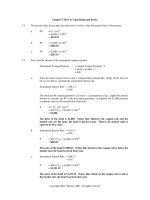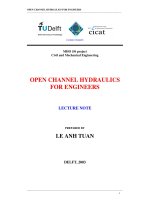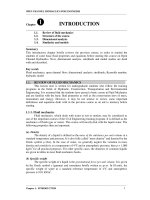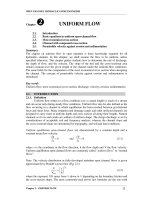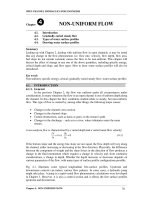- Trang chủ >>
- Khoa Học Tự Nhiên >>
- Vật lý
Tài liệu Open channel hydraulics for engineers. Chapter 5 spillways pptx
Bạn đang xem bản rút gọn của tài liệu. Xem và tải ngay bản đầy đủ của tài liệu tại đây (186.04 KB, 17 trang )
OPEN CHANNEL HYDRAULICS FOR ENGINEERS
-----------------------------------------------------------------------------------------------------------------------------------
----------------------------------------------------------------------------------------------------------------------------------
Chapter 5: SPILLWAYS
90
Chapter
SPILLWAYS
_________________________________________________________________________
5.1. Introduction
5.2. General formula
5.3. Sharp-crested weir
5.4. The overflow spillway
5.5. Broad-crested weir
_________________________________________________________________________
Summary
Spillways are familiar hydraulic structures built across a stream to control the water level.
This chapter emphasizes the classification of weirs and spillways as well as the application
of hydraulic formulas for designing their shape and dimensions.
Key words
Spillway; weir; crest; design head
________________________________________________________________________
5.1. INTRODUCTION
Spillways are used at both large and small dams for letting flood flows pass,
thereby preventing overtopping and failure of the dam. A spillway as sketched in Fig. 5.1
is the most common type. Three zones can be distinguished: the crest, the face and the toe
– each with its separate problems.
Fig. 5.1. General view of a spillway
A weir is a notch of regular form through which water flows. The term is also applied to
the structure containing such a notch. Thus a weir may be a depression in the side of a
tank, a reservoir, or a channel, or it may be an overflow dam or other similar structure.
Classified in accordance with the shape of the notch, there are rectangular weirs, triangular
or V-notch weirs, trapezoidal weirs, and parabolic weirs. Weirs are usually designed to
control water levels in rice fields or wetlands. They are commonly used as a means of flow
measurement.
Of primary importance for hydraulic structures considered in this chapter is the magnitude
of backwater level they cause upstream of the structure for the given discharge; that is, the
head-discharge relationship for the structure. Both gradually varied and rapidly varied
flows are possible through these structures, but one-dimensional methods of analysis
usually are sufficient and well-developed in this branch of hydraulics. Essential to the
crest
face
toe
OPEN CHANNEL HYDRAULICS FOR ENGINEERS
-----------------------------------------------------------------------------------------------------------------------------------
----------------------------------------------------------------------------------------------------------------------------------
Chapter 5: SPILLWAYS
91
“hydraulic approach” is the specification of empirical discharge coefficients that have been
well established by laboratory experiments and verified in the field. The determination of
controls in hydraulic analysis also is important, and critical depth often is the control of
interest. The energy equation and the specific-energy head diagram are useful tools in the
hydraulic analyses of this chapter.
5.2. GENERAL FORMULA
The equation for discharge over a weir cannot be derived exactly, because not only
the flow pattern of one weir differs from that of another, but also the flow pattern for a
given weir varies with the discharge. Furthermore, the number of variables involved is too
large to warrant a rigorous analytical approach. Approximate derivations are presented in
most texts. These derivations show effects of gravitational forces in an approximate
manner, but do not include the effects of viscosity, surface tension, the ratios of the
dimensions of the weir to the dimensions of the approach channel, the nature of the weir
crest, and the velocity distribution in the approach channel. A simplified derivation will be
made here to show the general character of the relationship between the discharge and the
most important variables and to demonstrate the nature of the effect of some of the
variables. The derivation will be made for sharp-crested weirs, but as will be shown later, a
similar derivation would apply to weirs that are not sharp-crested. Now, we consider a
rectangular weir, over which the water is flowing as shown in Fig. 5.2.
Fig. 5.2. Rectangular weir
Let, H = height of the water above the crest of the weir,
L = length of the weir, and
C
d
= coefficient of discharge (see Chapter 1).
Let us consider a horizontal strip of water of thickness dh at a depth h from the water
surface as shown in Fig. 5.2.
Area of the strip = L.dh (i)
Assuming that the flow does not contract when passing over the weir (i.e. neglecting
streamline curvature), and that the pressure is atmospheric across the vertical section above
the weir and the upstream velocities are small, the velocity of the water through the strip
can theoretically be derived to be:
H
dh
h
water surface
L
OPEN CHANNEL HYDRAULICS FOR ENGINEERS
-----------------------------------------------------------------------------------------------------------------------------------
----------------------------------------------------------------------------------------------------------------------------------
Chapter 5: SPILLWAYS
92
theoretical velocity =
2gh
(ii)
The discharge per unit width, q, flowing over a weir is generally expressed as:
d
dq C area of strip theoretical velocity
d
dq C .L.dh. 2gh
(iii)
The total discharge over the weir may be found by integrating the above equation within
the limits 0 and H:
H
3
H
2
3
2
d d d
o
0
h 2
Q C .L.dh. 2gh C .L. 2g. C .L. 2g.H
3
3
2
or the discharge per unit width, q, is:
3
2
d
2
q C 2g.H
3
(5-1)
where H is to be conceived of as the total upstream specific-energy head on the weir crest
supposing that the upstream velocities are negligibly small; C
d
is a discharge coefficient,
which can be approximated by Rehbock’s experimental formula (1929):
C
d
= 0.611 + 0.08
H
P
(5-2)
where P is measured from top of the crest of the weir to the bottom of the reservoir; P is
called the weir height. Assuming P very large, C
d
becomes equal to 0.611. In this case, Eq.
(5-1) can be written as:
3
2
q 1.80 H
[1.80] = m
½
s
-1
(5-3)
Experiments show that the rise from the sharp weir crest to the highest point of the nappe
(i.e. the “spillway crest”) is 0.11H (see Figs. 5.4 and 5.6). Using this fact we can express
Eq. (5-3) in terms of H
D
, the head over the spillway crest. We obtain:
3
2
D
q 2.14 H
[2.14] = m
½
s
-1
(5-4)
where H
D
may be termed the design head.
Example 5.1: A rectangular weir, 4.5 m long, has a head of water 30 cm. Determine the
discharge over the weir, if the coefficient of discharge is 0.6.
Solution:
Given: length of weir: L = 4.5 m
head of water: H = 30 cm = 0.3 m
coefficient of discharge: C
d
= 0.6
Discharge over the weir Q?
Using the relation:
OPEN CHANNEL HYDRAULICS FOR ENGINEERS
-----------------------------------------------------------------------------------------------------------------------------------
----------------------------------------------------------------------------------------------------------------------------------
Chapter 5: SPILLWAYS
93
3
2
d
2
Q C .L. 2g.H
3
= 1.31 m
3
/s Ans.
Example 5.2: The daily record of rainfall over a catchment area is 0.2 million m
3
. It has
been found that 80% of the rainfall reaches the storage reservoir and then passes over a
rectangular weir. What should be the length of the weir, if the water is not to rise more than
1 m above the crest? Assume a suitable value of the coefficient of discharge for the weir.
Solution:
Given: rainfall = 0.2 x 10
6
m
3
per day
discharge into the reservoir: Q = 80% of rainfall
Q = 0.8 x 0.2 x 10
6
m
3
/day = 1.85 m
3
/s
head of water: H = 1 m
Let, L = length of the weir
Take: coefficient of discharge: C
d
= 0.6
Using the relation:
3
2
d
2
Q C .L. 2g.H
3
1.85 = 1.77 L
L = 1.045 m Ans.
5.3. SHARP-CRESTED WEIR
5.3.1. Experiments on sharp-crested rectangular weirs
All tests on weirs of this type were made with the nappe fully aerated. When the
crest length L of a horizontal weir (see Fig. 5.3) is shorter than the width of the channel b,
as well as in the case of V-notch weirs, aeration is automatic. However, for horizontal
weirs extending over the full width of the channel, i.e. L/b = 1, air at atmospheric pressure
must be provided by vents. Otherwise the air beneath the nappe will be exhausted, causing
a reduction of pressure beneath the nappe, with a corresponding increase in the discharge
for a given head.
Fig. 5.3. Weirs, definition sketch
L
b
crest
V
2
V
2g
H
P
crest
2
2
V
2g
P
H
crest
section through
sharp-crested weir
horizontal-
crested weir
L/b < 1
V-notch weir
round-crested
weir
OPEN CHANNEL HYDRAULICS FOR ENGINEERS
-----------------------------------------------------------------------------------------------------------------------------------
----------------------------------------------------------------------------------------------------------------------------------
Chapter 5: SPILLWAYS
94
The sharp-crested weir is of fundamental interest, because its associated theory forms a
basis for the design of spillways. Because the edge is sharp, opportunities for boundary-
layer development are limited to the vertical face of the weir, where velocities are low; we
may therefore expect the flow to be substantially free from viscous effects and the resultant
energy dissipation.
Fig. 5.4. The sharp-crested weir
Fig. 5.4 shows a longitudinal section of flow over such a weir. An elementary analysis can
be made by assuming that the flow does not contract as it passes over the weir (i.e.
neglecting streamline curvature), and that the pressure is atmospheric across the whole
section AB. Under these assumptions the velocity at any point such as C is equal to
2gh
(Henderson, 1966), and the discharge q per unit width accordingly equal to:
2
o
2
o
3 3
V
2 2
2 2
H
2g
o o
V
2g
V V2
2ghdh 2g H
3 2g 2g
(5-5)
the depth h being measured downwards form the total energy-head line, and not from the
upstream water surface. V
o
is the approach velocity to the weir.
The effect of the flow contraction may be expressed by a contraction coefficient C
c
leading
finally to the result:
3 3
2 2
2 2
3
o o
2
c d
V V2 2
q C 2g H C 2g.H
3 2g 2g 3
(5-6)
where the discharge coefficient:
3 3
2 2
2 2
o o
d c
V V
C C 1
2gH 2gH
(5-7)
We should expect both C
c
and the ratio (V
o
2
/2gH) to be dependent on the boundary
geometry alone, in particular on the ratio H/P; it follows that C
d
should be a function of
H/P alone, which was indeed found by Rehbock (1929); see Eq. (5-2).
H
h
V
o
45
A
B
2
o
V
2g
2
V
2g
p
p
total energy-head line
P
C
2
V
2g
OPEN CHANNEL HYDRAULICS FOR ENGINEERS
-----------------------------------------------------------------------------------------------------------------------------------
----------------------------------------------------------------------------------------------------------------------------------
Chapter 5: SPILLWAYS
95
In early experiments on weirs only small quantities of water were available. In most cases
results are given in the form of Eq. (5-1), with a discharge coefficient C
d
.
Tests on weirs of this type were conducted by Kindsvater and Carter (1959). Their
tests cover a range of values of H/P from approximately 0.1 to 2.5, a range of heads from 3
cm to 22 cm, and weir heights from 9 cm to 44 cm. They also varied the weir length and
the channel width from 3 cm to 82 cm. In presenting their data they adopted the method
used by Rehbock of including the effect of H in the main body of the equation. Kindsvater
and Carter also introduced a method that includes the effect of the weir length L in the
main body of the equation. Their method is shown in the following three equations:
3
2
e e
Q C .L .H
(5-8)
e L
L L k
(5-9)
e H
H H k
(5-10)
In these equations k
L
and k
H
are factors representing the effects of viscosity and surface
tension, and the subscript e indicates effective values, that is, H
e
is the effective energy-
head. By treating the variables in this manner the authors were able to obtain a single linear
relationship between C
e
and H/P for all values of H. The values of k
L
and k
H
were obtained
by trying successive values of k
L
and k
H
until the values of C
e
were obtained that were the
most independent of H and L. They did this not only for their own data, but for several
other groups of experiments as well.
Their equations for C
e
, with correcponding values of k
H
and k
L
are given hereafter.
The Kindsvater and Carter tests yielded
e
H
C 1.78 0.22
P
(5-11)
k
H
= 0.001 m; k
L
= - 0.001 m
The Bazin tests yielded
e
H
C 1.80 0.25
P
(5-12)
k
H
= 0.004 m; k
L
= 0 m
The Schoder and Turner tests yielded
e
H
C 1.77 0.25
P
(5-13)
k
H
= 0.001 m; k
L
= 0 m



